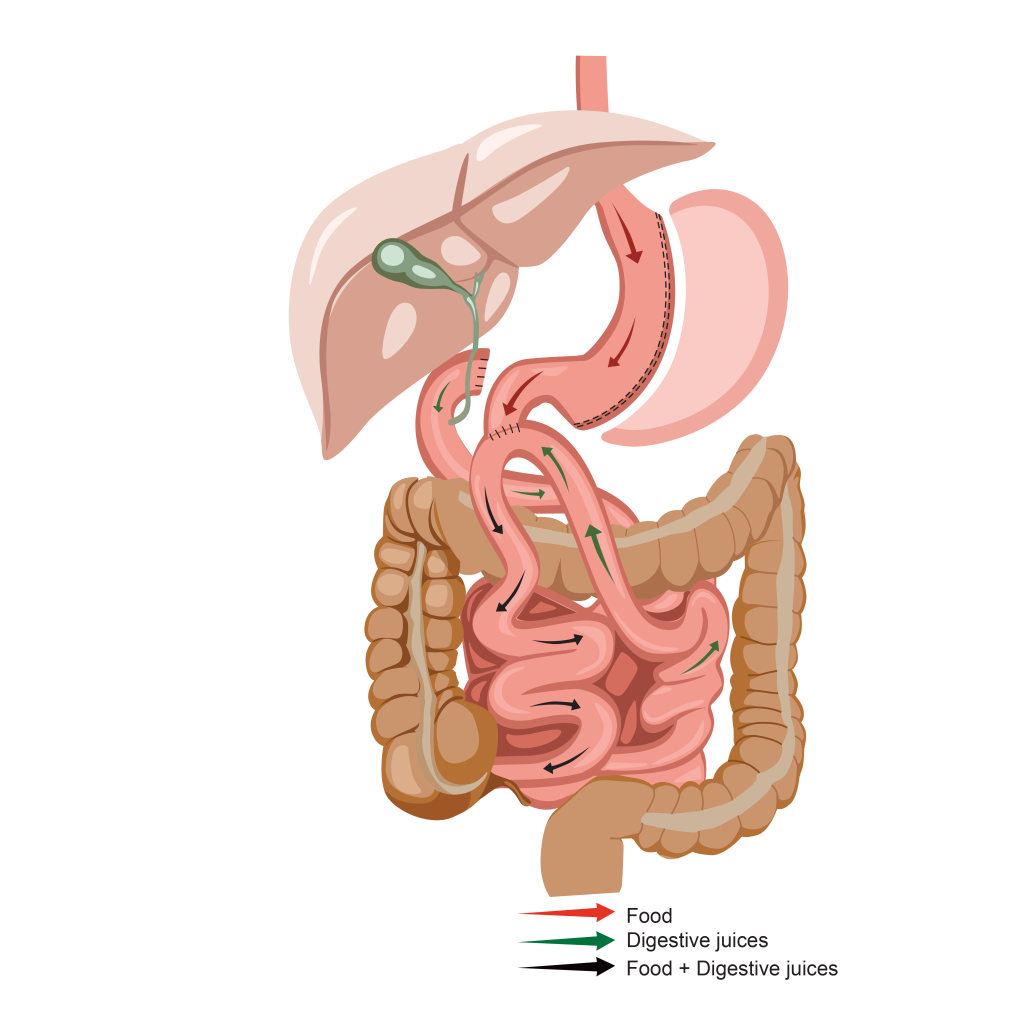Single Anastomosis Duodenoileostomy with Sleeve Gastrectomy (SADI-S)
What is Single Anastomosis Duodenoileostomy with Sleeve Gastrectomy?
The SADI-S (Single Anastomosis Duodenoileostomy with Sleeve Gastrectomy) is a newer form of the duodenal switch procedure, utilised for over three decades in treating morbid obesity.
SADI-S integrates the advantages of sleeve gastrectomy and intestinal bypass, offering a loop configuration to reduce the risks associated with marginal ulcers and internal hernias whilst simplifying operation.
In sleeve gastrectomy, about 75% of the stomach is removed, which limits the capacity for food intake and decreases levels of ghrelin, the hormone responsible for stimulating hunger. The intestinal bypass aspect of the procedure involves dividing the upper section of the small intestine (duodenum) just past the stomach's exit (pylorus) and then connecting the lower part of the small intestine (ileum) to this upper section.

This surgical technique causes food to bypass a portion of the small intestine, leading to a reduction in the absorption of nutrients. This is a key mechanism through which the procedure aids in weight loss and management of obesity.
Who is a Candidate for SADI-S Surgery?
You may be eligible for a SADI-S if you
- Meet criteria for weight loss surgery (see ‘Am I a candidate?’)
- Have a higher BMI
- Have obesity-related metabolic comorbidities such as type 2 diabetes mellitus
- As part of a planned two-stage operation after sleeve gastrectomy
- Require a revision procedure after bariatric surgery, such as a sleeve gastrectomy
- Demonstrate commitment to strict lifelong adherence to nutritional supplementation due to the higher rate of nutrient deficiencies
SADI-S is the most effective means of losing more weight in those patients who have already had a sleeve gastrectomy.
Benefits of SADI-S Surgery
Studies show SADI-S can provide greater weight loss than a standard sleeve gastrectomy or Roux-en-Y gastric bypass. Some other advantages of SADI-S include:
- Combines benefits of sleeve and bypass
- Excellent weight loss outcomes
- Less risk of dumping syndrome
- Less risk of internal hernia
- Less risk of marginal ulcers
- Minimal risk of bile reflux gastritis
- May improve reflux symptoms
- High rates of resolution of obesity-related comorbidities
- Lower rates of long-term anastomotic complications compared to Roux-en-Y gastric bypass
What Happens During SADI-S Procedure?
SADI consists of two steps. In the first one, called “sleeve gastrectomy”, the stomach is reduced and narrowed into a tube to reduce the stomach capacity.
In the second step, a small bowel bypass is performed to reduce the surface area available for food absorption. Specifically, the middle part of the small bowel is excluded from food transit.
The first portion of the small bowel, the duodenum, is divided, and a loop of the small bowel (the portion known as the ileum) is connected (anastomosed) to the duodenum (on the stomach side). Thus, after this second step, the first part of the small bowel (the duodenum) is connected to the distal small bowel (the ileum).
In short, after this operation, food travels from the new narrow stomach to the distal intestine, bypassing a long segment of the small bowel, which remains in the abdominal cavity but is excluded from food absorption. These anatomical changes decrease oral intake and reduce the absorption of the nutrients and calories eaten.
Postoperative Care Plan for SADI-S
Following your surgery, you will typically spend two nights in the hospital and be administered pain-controlling medications to keep you comfortable.
You will be kept on a liquid diet for the first two weeks following your surgery. Drinking plenty of fluids throughout the day is important to avoid dehydration.
Your surgeon and dietician will give you a specific diet plan and instructions to follow after this.
After your first procedure, your diet will be strictly limited to clear liquids initially, then other types of liquids, such as protein shakes and non-fat milk. You will follow our bariatric diet through its four stages.
It is particularly important that you consistently take your multivitamins and any prescribed additional supplements after this procedure. Your nutrient levels will be closely monitored throughout your follow-up.
SADI-S Surgery Risks
Your surgeon will explain all of the risks and benefits of this surgery to you before you undergo the procedure.






